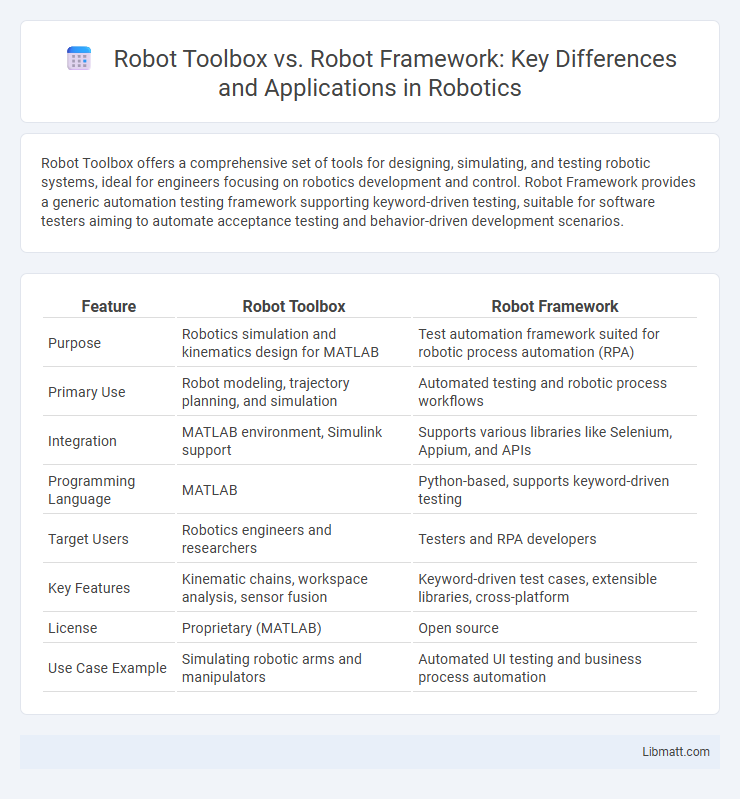Robot Toolbox offers a comprehensive set of tools for designing, simulating, and testing robotic systems, ideal for engineers focusing on robotics development and control. Robot Framework provides a generic automation testing framework supporting keyword-driven testing, suitable for software testers aiming to automate acceptance testing and behavior-driven development scenarios.
Table of Comparison
| Feature | Robot Toolbox | Robot Framework |
|---|---|---|
| Purpose | Robotics simulation and kinematics design for MATLAB | Test automation framework suited for robotic process automation (RPA) |
| Primary Use | Robot modeling, trajectory planning, and simulation | Automated testing and robotic process workflows |
| Integration | MATLAB environment, Simulink support | Supports various libraries like Selenium, Appium, and APIs |
| Programming Language | MATLAB | Python-based, supports keyword-driven testing |
| Target Users | Robotics engineers and researchers | Testers and RPA developers |
| Key Features | Kinematic chains, workspace analysis, sensor fusion | Keyword-driven test cases, extensible libraries, cross-platform |
| License | Proprietary (MATLAB) | Open source |
| Use Case Example | Simulating robotic arms and manipulators | Automated UI testing and business process automation |
Introduction to Robot Toolbox and Robot Framework
Robot Toolbox is a MATLAB-based environment designed for robot modeling, simulation, and algorithm development, providing tools for kinematics, dynamics, and control system design. Robot Framework is an open-source, Python-based test automation framework used primarily for automated acceptance testing and robotic process automation (RPA), supporting keyword-driven testing and integration with various testing libraries. Both tools cater to different aspects of robotics and automation, with Robot Toolbox focusing on engineering and simulation, while Robot Framework emphasizes software testing and process automation.
Key Features Comparison
Robot Toolbox offers advanced simulation capabilities, 3D visualization, and precise robot kinematics modeling, making it ideal for robotic design and control development. Robot Framework emphasizes automated testing, featuring keyword-driven testing, extensive library support, and easy integration with various testing tools to streamline software quality assurance. Your choice depends on whether you need robust robotic simulation (Robot Toolbox) or flexible test automation (Robot Framework).
Supported Programming Languages
Robot Toolbox primarily supports MATLAB for robotic algorithm development and simulation, offering seamless integration with MATLAB's extensive numerical computing environment. Robot Framework, on the other hand, is a generic test automation framework supporting multiple programming languages such as Python, Java, and .NET, enabling versatile test scripting and execution across various platforms. Your choice depends on whether you need MATLAB-centric robotics tools or a multi-language automation framework.
Ease of Use and Learning Curve
Robot Toolbox offers a user-friendly interface and intuitive functions that significantly reduce the learning curve for beginners in robotics and automation. Robot Framework, while powerful and versatile, requires more initial setup and familiarity with test automation concepts, which can be challenging for new users. Your choice depends on whether you prioritize a quick start with simpler tools (Robot Toolbox) or need a robust, scalable testing solution (Robot Framework).
Integration Capabilities
Robot Toolbox offers seamless integration with MATLAB and Simulink, enabling advanced robotics simulation and control algorithm development within a unified environment. Robot Framework excels in integrating with a wide range of external tools, libraries, and test automation platforms through its keyword-driven architecture, making it highly versatile for automated testing and continuous integration pipelines. Your choice depends on whether you prioritize simulation-centric development or flexible test automation integration.
Community and Ecosystem Support
Robot Framework boasts a large, active community and extensive ecosystem support, offering numerous plugins, libraries, and integrations that continually evolve with user contributions. Robot Toolbox, while powerful, has a smaller, more specialized user base with limited third-party extensions and fewer community-driven resources. Your choice should reflect the importance of broad community engagement and diverse ecosystem support for your automation projects.
Application Domains and Use Cases
Robot Toolbox primarily serves robotics engineers and researchers by providing simulation, modeling, and code generation tools for developing robotic systems in industrial automation, autonomous vehicles, and robotic arms. Robot Framework targets software testers and developers, focusing on acceptance testing, robotic process automation (RPA), and test-driven development across web applications, APIs, and enterprise software. Your choice depends on whether you need physical robot design and control (Robot Toolbox) or automated testing and process automation workflows (Robot Framework).
Performance and Scalability
Robot Framework offers superior scalability for large-scale test automation projects due to its modular architecture and extensive library support, enabling efficient management of complex test suites. Robot Toolbox, while performant for smaller tasks, may encounter limitations handling high concurrency and large data volumes compared to Robot Framework's optimized execution engine. Your choice should consider Robot Framework for enterprise-level automation requiring robust performance and seamless scalability.
Cost and Licensing
Robot Toolbox offers a commercial licensing model with subscription-based pricing tailored for industrial automation and advanced robotics integration, while Robot Framework is an open-source test automation tool available under the Apache 2.0 License, making it free for personal and commercial use. Your choice may hinge on budget constraints and the need for vendor support, as Robot Toolbox provides professional support and regular updates, whereas Robot Framework relies on community contributions. Evaluating the total cost of ownership, including licensing fees and maintenance, is crucial when deciding between these platforms.
Conclusion: Which Should You Choose?
Robot Toolbox offers advanced simulation capabilities and real-time robot control suited for engineers and developers requiring precise modeling and testing environments, while Robot Framework focuses on keyword-driven test automation, ideal for software testers seeking flexibility and simplicity in automating acceptance testing. Choose Robot Toolbox if your priority is detailed robotic system design and hardware integration, and opt for Robot Framework when emphasizing versatile, scalable test automation across multiple software platforms. Evaluating project requirements, expertise, and application context ensures selecting the most effective tool for your robotics or testing needs.
Robot Toolbox vs Robot Framework Infographic

 libmatt.com
libmatt.com